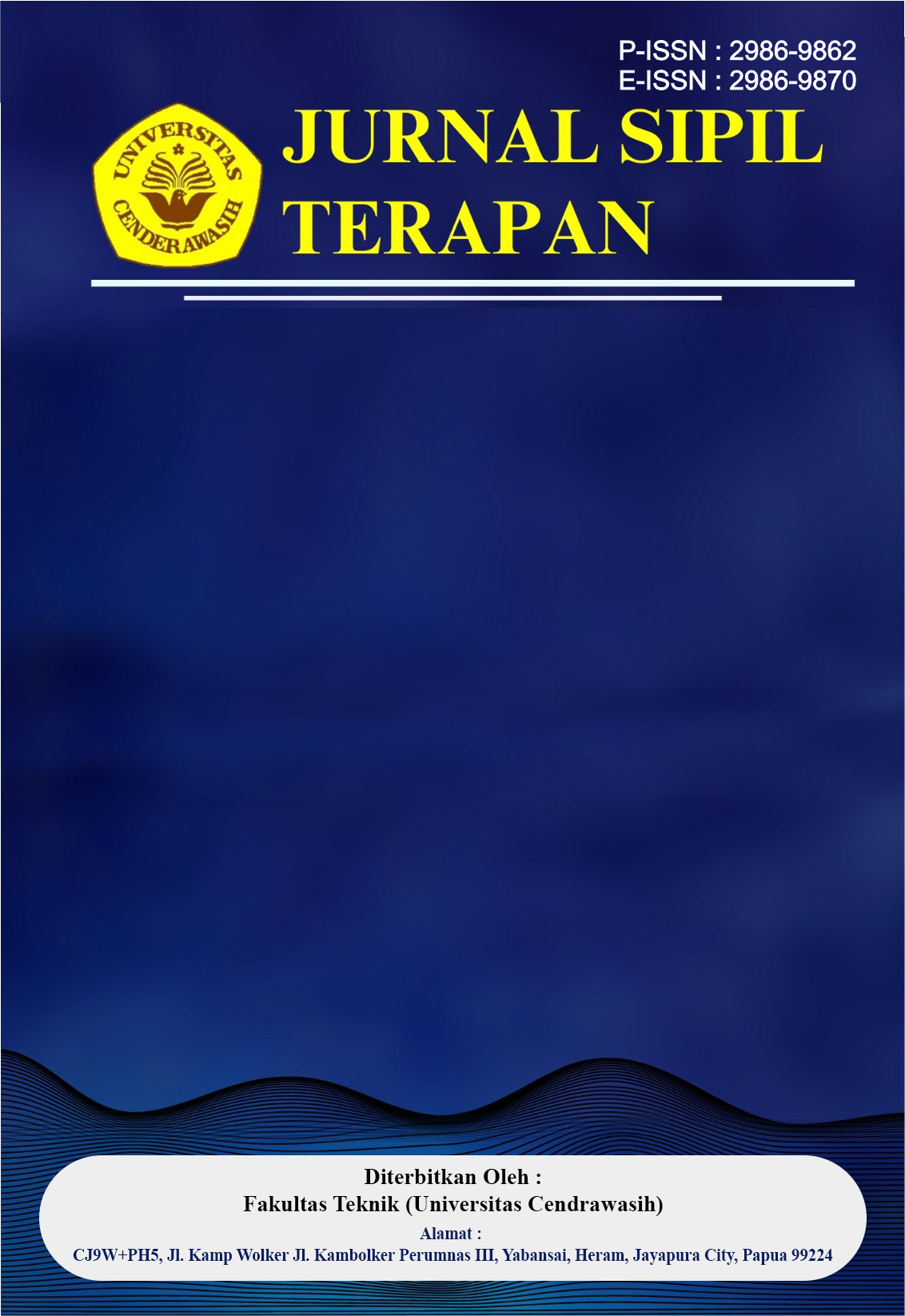Kinerja Mortar dengan Substitusi Abu Sekam Padi sebagai Bahan Pozzolanan
DOI:
https://doi.org/10.58169/jusit.v3i1.746Keywords:
Cement substitution, Compressive strength, Mortar, Porosity, Rice husk ashAbstract
Rice husk ash (RHA) is an agricultural waste rich in silica with potential as a partial cement substitute in mortar to support sustainable construction. This study evaluates the effect of varying RHA content on the compressive strength and porosity of mortar at 28 and 240 days of age. Mortar was prepared with RHA substitutions of 0%, 10%, 20%, and 30% by cement weight. Compressive strength was tested according to SK SNI 03-2834-2000, while porosity testing followed ASTM C642 standard. The results showed that 20% RHA substitution provided high compressive strength with acceptable porosity. In contrast, 30% RHA significantly increased porosity and sharply reduced compressive strength. These findings suggest that using RHA in the range of 10–20% can improve material efficiency without compromising mechanical performance. The study supports the development of environmentally friendly construction materials through the optimal use of agricultural waste.References
Alharthai, M., et al. (2025). Enhancing concrete strength and durability through incorporation of rice husk ash and high recycled aggregate. Case Studies in Construction Materials, 22, e04152. https://doi.org/10.1016/j.cscm.2024.e04152
Amin, M. N., et al. (2019). Pozzolanic reactivity and the influence of rice husk ash on early-age autogenous shrinkage of concrete. Frontiers in Materials, 6, 150. https://doi.org/10.3389/fmats.2019.00150
Amran, M., et al. (2021). Rice husk ash-based concrete composites: A critical review of their properties and applications. Crystals, 11(2), 168. https://doi.org/10.3390/cryst11020168
Bheel, N., et al. (2019). Use of rice husk ash as cementitious material in concrete. Engineering, Technology & Applied Science Research, 9(3), 4209–4212. https://doi.org/10.48084/etasr.2746
Capelo, A. R., Mármol, G., & Rossignolo, J. A. (2023). Optimization of the rice husk ash production process for the manufacture of magnesium silicate hydrate cements. Journal of Cleaner Production, 425, 138891. https://doi.org/10.1016/j.jclepro.2023.138891
Dasar, A., & Patah, D. (2021). Pasir dan kerikil sungai Mappili sebagai material lokal untuk campuran beton di Sulawesi Barat. Bandar: Journal of Civil Engineering, 3(2), 9–14.
Dasar, A., et al. (2023). Perbandingan kinerja bata beton menggunakan abu cangkang sawit, abu sekam padi dan abu serat sagu. JTT (Jurnal Teknologi Terpadu), 11(2), 241–248. https://doi.org/10.32487/jtt.v11i2.1797
Erarslan, N. (2023). Investigation of the tensile-shear failure of asphalt concrete base (ACB) construction materials using a non-linear cohesive crack model and critical crack threshold analysis. Construction and Building Materials, 364, 129901. https://doi.org/10.1016/j.conbuildmat.2022.129901
Hu, L., He, Z., & Zhang, S. (2020). Sustainable use of rice husk ash in cement-based materials: Environmental evaluation and performance improvement. Journal of Cleaner Production, 264, 121744. https://doi.org/10.1016/j.jclepro.2020.121744
Khan, M. N. N., et al. (2015). Utilization of rice husk ash for sustainable construction: A review. Research Journal of Applied Sciences, Engineering and Technology, 9(12), 1119–1127. https://doi.org/10.19026/rjaset.9.2606
Marangu, J. M., et al. (2024). Durability of ternary blended concrete incorporating rice husk ash and calcined clay. Buildings, 14(5), 1201. https://doi.org/10.3390/buildings14051201
Mohamad, M. E., et al. (2016). A review of the mechanical properties of concrete containing biofillers. IOP Conference Series: Materials Science and Engineering, 160(1), 012064. https://doi.org/10.1088/1757-899X/160/1/012064
Noor, N. M., et al. (2025). The effect of utilising coal ash as substitutes for cement and sand on compressive strength and water permeability of concrete. IOP Conference Series: Earth and Environmental Science, 1453(1), 012006. https://doi.org/10.1088/1755-1315/1453/1/012006
Patah, D., & Dasar, A. (2022). Strength performance of concrete using rice husk ash (RHA) as supplementary cementitious material (SCM). Journal of the Civil Engineering Forum, 261–276. https://doi.org/10.22146/jcef.3488
Patah, D., & Dasar, A. (2023). The impact of using rice husks ash, seawater and sea sand on corrosion of reinforcing bars in concrete. Journal of the Civil Engineering Forum, 251–262. https://doi.org/10.22146/jcef.6016
Patah, D., Dasar, A., & Nurdin, A. (2025). Sustainable concrete using seawater, sea-sand, and ultrafine palm oil fuel ash: Mechanical properties and durability. Case Studies in Construction Materials, 22, e04129. https://doi.org/10.1016/j.cscm.2024.e04129
Patah, D., et al. (2023). Strength development of seawater mixed and cured concrete with various replacement ratios of fly ash. Materials Science Forum, 1091, 111–118. https://doi.org/10.4028/p-1ckry6
Patah, D., et al. (2024). The impact of fly ash and sea sand on strength and durability of concrete. Key Engineering Materials, 1000, 23–33. https://doi.org/10.4028/p-o0WA24
Saad, S. A., et al. (2015). Pozzolanic reaction mechanism of rice husk ash in concrete – A review. Applied Mechanics and Materials, 773–774, 1143–1147. https://doi.org/10.4028/www.scientific.net/AMM.773-774.1143
Siddika, A., et al. (2021). State-of-the-art-review on rice husk ash: A supplementary cementitious material in concrete. Journal of King Saud University - Engineering Sciences, 33(5), 294–307. https://doi.org/10.1016/j.jksues.2020.10.006
Singh, R. R., & Singh, D. (2019). Effect of rice husk ash on compressive strength of concrete. International Journal of Structural and Civil Engineering Research, 223–226. https://doi.org/10.18178/ijscer.8.3.223-226
Zhang, J. X., et al. (2025). The effect of adding rice husk ash (RHA) and calcined shell powder (CSP) on the properties of cement mortar. Case Studies in Construction Materials, 22, e04426. https://doi.org/10.1016/j.cscm.2025.e04426
Downloads
Published
How to Cite
Issue
Section
License
Copyright (c) 2025 Jurnal Sipil Terapan

This work is licensed under a Creative Commons Attribution-ShareAlike 4.0 International License.










